-
Etymology
- Derived from the term “beaded,” describing the nodular or bead-like appearance along interlobular septa, and “septum,” referring to the interlobular connective tissue framework in the lungs. The sign resembles a string of beads on imaging.
AKA
- Beaded interlobular septa
- Nodular septal thickening
Definition
What is it?
- The beaded septum sign refers to the nodular thickening of the interlobular septa visible on high-resolution CT (HRCT). This radiologic sign is associated with diseases that cause lymphatic, vascular, or interstitial infiltration of the septa.
Caused by:
- Diseases infiltrating or obstructing lymphatics, vessels, or interstitial spaces, such as:
- Lymphangitic carcinomatosis
- Sarcoidosis
- Lymphoma
- Silicosis or coal workers’ pneumoconiosis
- Amyloidosis
Resulting in:
- Nodular or bead-like irregularities along interlobular septa
- Disruption of normal smooth interlobular septal architecture
Structural Changes:
- Thickened interlobular septa with discrete nodular or bead-like formations
- Possible involvement of adjacent lymphatics, vessels, or interstitial spaces
Pathophysiology:
- Nodular septal thickening occurs when interstitial or lymphatic processes result in infiltration or obstruction within the interlobular septa. This may involve:
- Tumor cells (e.g., lymphangitic carcinomatosis)
- Granulomas (e.g., sarcoidosis)
- Deposition of abnormal proteins (e.g., amyloidosis)
- Fibrosis or scarring (e.g., silicosis)
Pathology:
- Discrete nodules within thickened interlobular septa
- Associated findings such as interstitial fibrosis, granulomas, or vascular remodeling
Diagnosis
Clinical:
- Symptoms vary depending on the underlying cause and may include:
- Dyspnea
- Cough
- Systemic symptoms (e.g., fever, weight loss in malignancy or granulomatous disease)
Radiology:
- High-Resolution CT (HRCT):
- Beaded or nodular thickening along interlobular septa
- Perilymphatic distribution in diseases like sarcoidosis
- Reticulonodular pattern in associated interstitial diseases
Labs:
- Elevated tumor markers in malignancy (e.g., lymphangitic carcinomatosis)
- Serum ACE and calcium in sarcoidosis
- Biopsy or cytology confirming specific diagnoses (e.g., amyloid deposition, malignancy)
Treatment
- Directed at the underlying cause:
- Chemotherapy for malignancy
- Corticosteroids for sarcoidosis or other inflammatory conditions
- Supportive measures for fibrotic diseases
Radiology
CXR
Findings:
- Typically non-specific but may show diffuse interstitial markings or reticulonodular patterns
- Subtle nodular septal thickening in advanced cases
Associated Findings:
- Bilateral lymphadenopathy in diseases like sarcoidosis
- Effusions or pleural thickening depending on the underlying cause
CT
Parts:
- Interlobular septa of secondary pulmonary lobules
Size:
- Nodules are typically small, measuring a few millimeters
Shape:
- Discrete bead-like nodules arranged along the septa
Position:
- Uniformly distributed along interlobular septa; commonly affects multiple lobules
Character:
- Smooth or irregular nodular septal thickening
- Often associated with perilymphatic distribution in diseases like sarcoidosis
Time:
- Progressive in chronic diseases (e.g., sarcoidosis, silicosis)
- Rapid onset in aggressive conditions like lymphangitic carcinomatosis
Associated Findings:
- Enlarged mediastinal or hilar lymph nodes in sarcoidosis or lymphangitic carcinomatosis
- Ground-glass opacities or reticulations in associated interstitial diseases
Other relevant Imaging Modalities
MRI/PET CT/NM/US/Angio:
- PET-CT: Useful for identifying metabolic activity in nodular infiltrates, especially in malignancy or granulomatous disease
- Ultrasound: Limited role but may assess pleural effusion if present
Pulmonary Function Tests (PFTs):
- May show restrictive pattern in advanced interstitial diseases
- Normal in early or mild disease
Recommendations
- Perform high-resolution CT for detailed evaluation of nodular septal thickening
- Obtain biopsy or bronchoscopy with lavage for tissue diagnosis when clinical and imaging findings are inconclusive
- Correlate imaging findings with clinical symptoms and laboratory results to guide diagnosis and management
Key Points and Pearls
- The beaded septum sign is a hallmark of lymphatic or interstitial processes infiltrating the interlobular septa.
- High-resolution CT is the imaging modality of choice to identify and characterize this finding.
- Common causes include lymphangitic carcinomatosis, sarcoidosis, and silicosis.
- Differentiation from smooth septal thickening (seen in conditions like pulmonary edema) is essential for diagnosis.
- Clinical correlation and further evaluation, such as biopsy or PET-CT, may be required to determine the underlying cause.
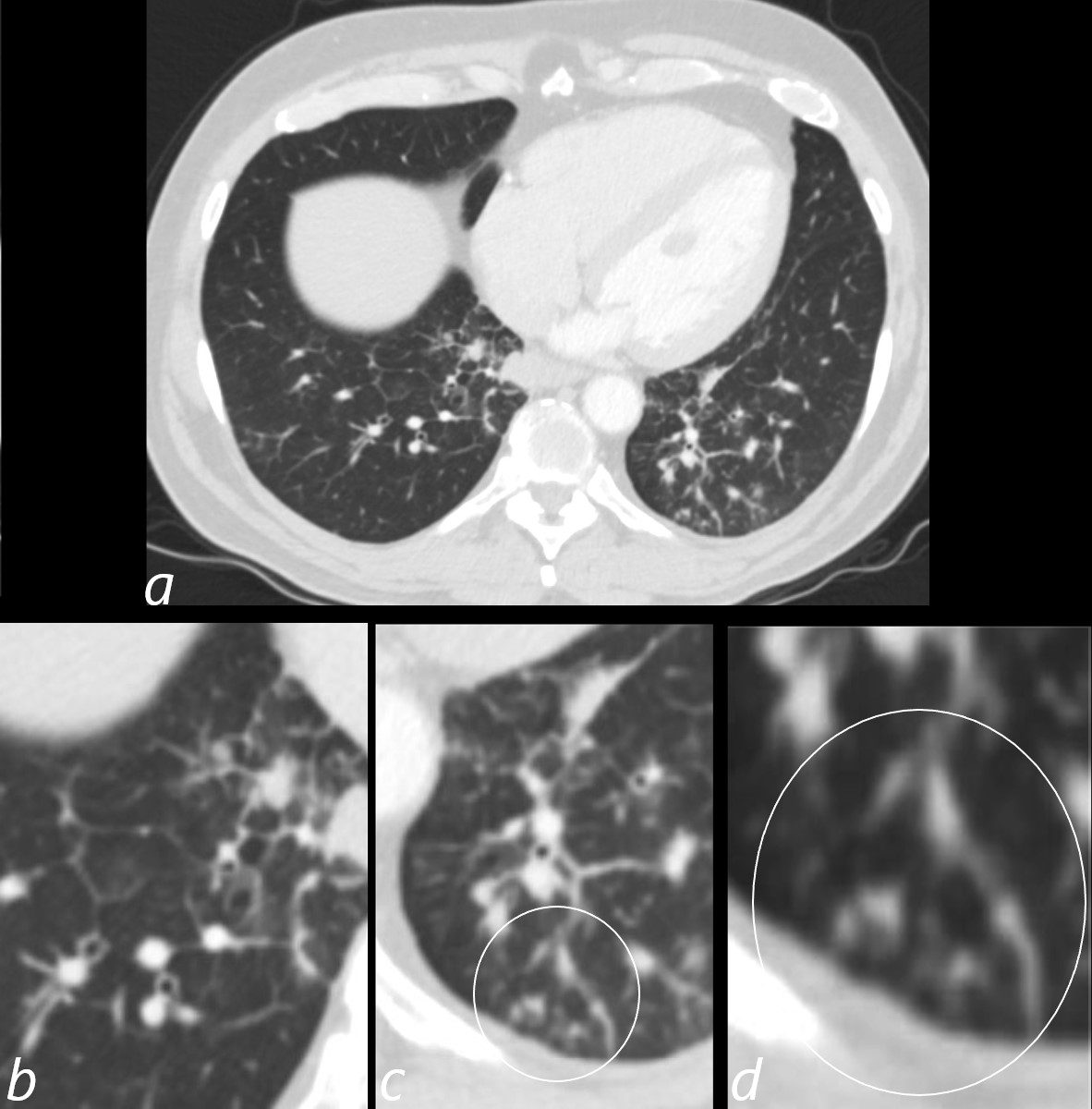
3 months later the patient presented with chest pain and a cough. CT of the chest in the axial plane shows new bilateral lower lobar regions of irregular interlobular septal thickening noted in the right lower lobe a, magnified in b). Ringed in image c and d are 2 side by side secondary lobules with irregular septal thickening centrilobular nodules and other intralobular nodules likely reflecting lymphatic involvement.
Given the changes in the right upper lobe these findings likely reflect lymphangitis carcinomatosa
Ashley Davidoff MD TheCommonVein.net 013Lu 136062cL

72 year old female showing reticular changes at the lung bases characterised by irregular thickening of the interlobular septa geometric distortion of the secondary lobules changes Ashley Davidoff TheCommonVein.net
136228
Reticulation ILD Geometric Distortion of the Secondary Lobules
72 year old female showing reticular changes at the lung bases characterised by irregular thickening of the interlobular septa geometric distortion of the secondary lobules changes Ashley Davidoff TheCommonVein.net
136229
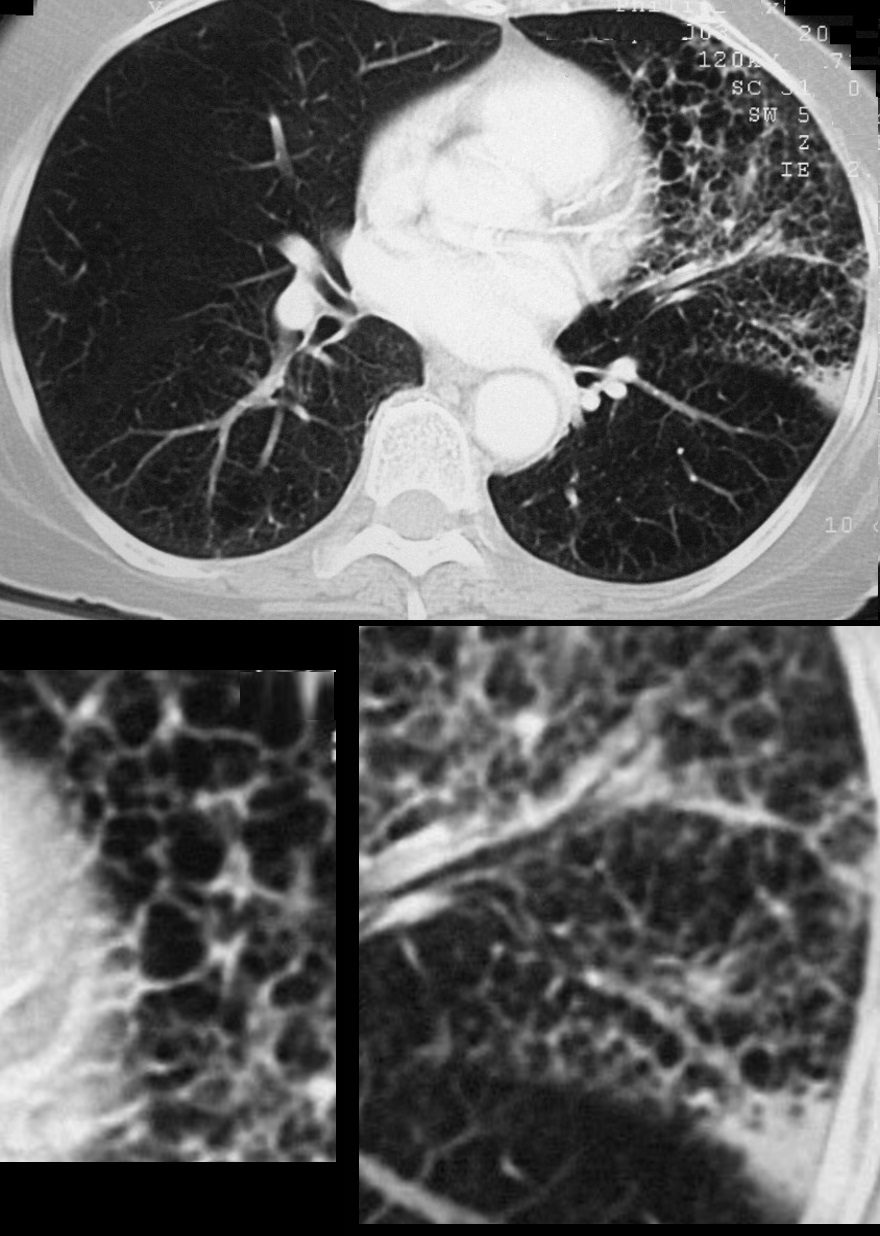
70-year-old female presents with a cough, fever and leukocytosis. CT in the axial plane shows extensive lymphangitis characterized by thickening of the interlobular septa in the inferior aspect of the upper lobe below the necrotizing pneumonia.
Ashley Davidoff MD TheCommonVein.net 260Lu 31631c

3 months later the patient presented with chest pain and a cough. CT of the chest in the axial plane shows new bilateral lower lobar regions of irregular interlobular septal thickening noted in the right lower lobe a, magnified in b). Ringed in image c and d are 2 side by side secondary lobules with irregular septal thickening centrilobular nodules and other intralobular nodules likely reflecting lymphatic involvement.
Given the changes in the right upper lobe these findings likely reflect lymphangitis carcinomatosa
Ashley Davidoff MD TheCommonVein.net 013Lu 136062cL
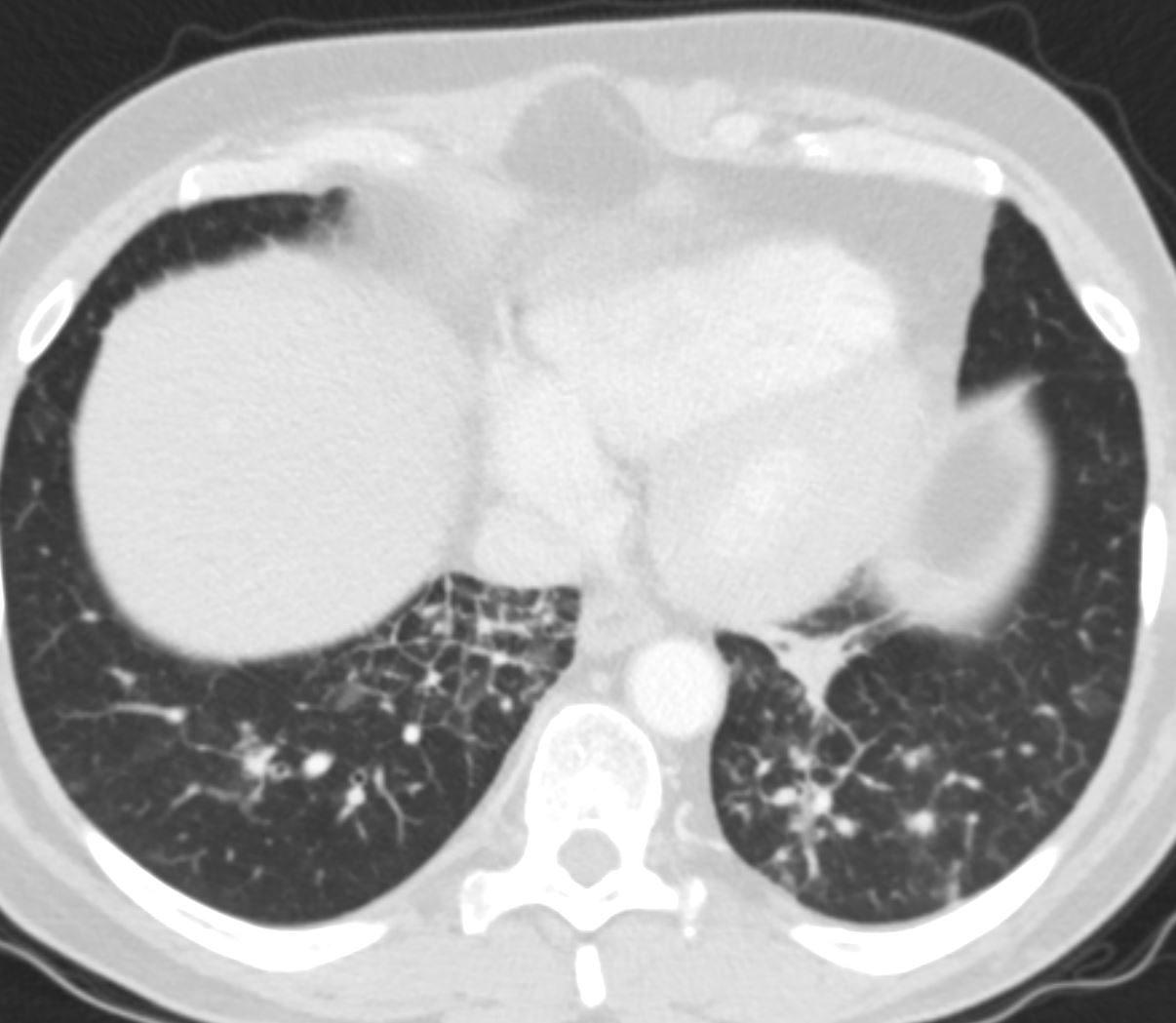
3 months later the patient presented with chest pain and a cough. CT of the chest in the axial plane shows new bilateral lower lobar regions of irregular interlobular septal thickening bilaterally more prominent on the right with nodular changes at the left base.
Given the changes in the right upper lobe these findings likely reflect lymphangitis carcinomatosa
Ashley Davidoff MD TheCommonVein.net 013Lu 136063
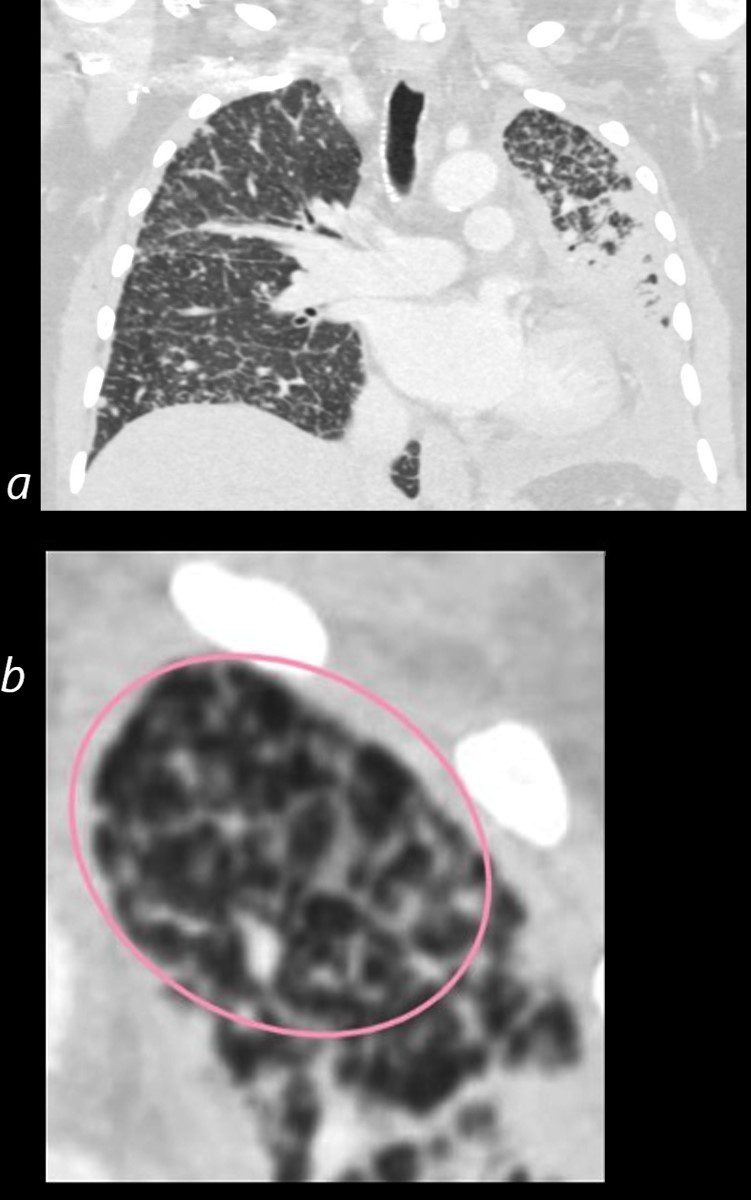
50 year old female with primary adenocarcinoma with the primary lesion presenting as pneumonic consolidation of the left lower lobe, and diffuse reticulonodular changes bilaterally
Image b is a magnified view of the left upper lobe and shows nodular thickening of the interlobular septa representing lymphatic spread along the lymphovascular bundles (pink oval)
The right lung shows interlobular septal thickening centrilobular nodules, and nodular thickening of the minor fissure
These findings are consistent with the diagnosis of lymphangitis carcinomatosa
Ashley Davidoff MD TheCommonVein.net 158Lu 131023c01L
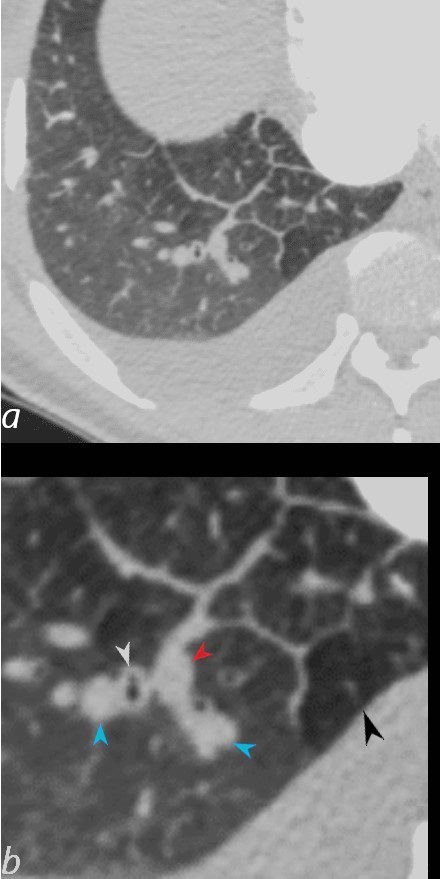
50-year-old female with diabetes, chronic renal failure and congestive heart failure. CT in the axial plane through the right posterior recess, shows thickened interlobular septa at the right base, congested arterioles (light blue arrowheads, b), alongside the bronchioles, peribronchial cuffing (white arrowheads, b), a congested pulmonary venule in the interlobular septum (red arrowhead arrowheads, b), ground glass changes and a secondary lobule demonstrating mosaic attenuation (black arrowhead arrowheads, b). The IVC is dilated and a small complex effusion is present.
Ashley Davidoff MD TheCommonvein.net 135783cL 193Lu

74-year-old man presents with dyspnea and orthopnea. CT shows thickening of the interlobular septa (Kerley B lines), peribronchial cuffing, and enlargement of the lobular arteriole in the right lower lobe. There is a suggestion of vasoconstriction of the arteriole as it enters the secondary lobule. ground glass changes in the some of the secondary lobules on the left and perhaps mosaic attenuation vs normal secondary lobule at the right base are noted. Additionally, there are small bilateral effusions right greater than left. The mild irregular shape of the effusions suggests that they are partially loculated. These findings indicate moderate congestive heart failure with interstitial edema.
Ashley Davidoff MD TheCommonVein.net 135775c01
Culture
Beads have played a significant role in various cultures worldwide, serving as symbols of status, spirituality, and artistic expression. Here are some notable examples:
Maasai Beadwork
The Maasai people of Kenya and Tanzania are renowned for their intricate beadwork, which conveys social status, age, marital status, and other cultural identifiers. Each color and pattern holds specific meanings, making each piece a unique cultural identifier.
Zulu Beadwork
In Zulu culture, beadwork is a form of expression, particularly among women. Beaded ornaments are created for family members and convey aspects of the wearer’s identity and social status.
Native American Beadwork
Various Native American tribes, such as the Lakota and Kiowa, have rich traditions of beadwork. Beads are used to create intricate designs on clothing and accessories, often holding cultural and spiritual significance.
Venetian Glass Beads
Venice has a long history of glass bead production, with beads being integral to trade networks between Europe, Africa, and the Americas. These beads influenced local bead-making traditions and were integrated into indigenous cultures.
Literature
Shakespeare
The only Shakespeare quote that directly mentions “beads” is from “Richard II” where the line reads, “I’ll give my jewels for a set of beads, My gorgeous palace for a hermitage…”. This line essentially expresses the idea of willingly giving up luxurious possessions for something simple and spiritual.
Ralph Waldo Emerson
Dream delivers us to dream, and there is no end to illusion. Life is like a train of moods like a string of beads, and, as we pass through them, they prove to be many-colored lenses which paint the world their own hue. . . .
Links and References
Fleischner Society
beaded septum sign
CT scans.—This sign consists of irregular and nodular thickening of interlobular septa reminiscent of a row of beads (,Fig 10). It is frequently seen in lymphangitic spread of cancer and less often in sarcoidosis (,24).

